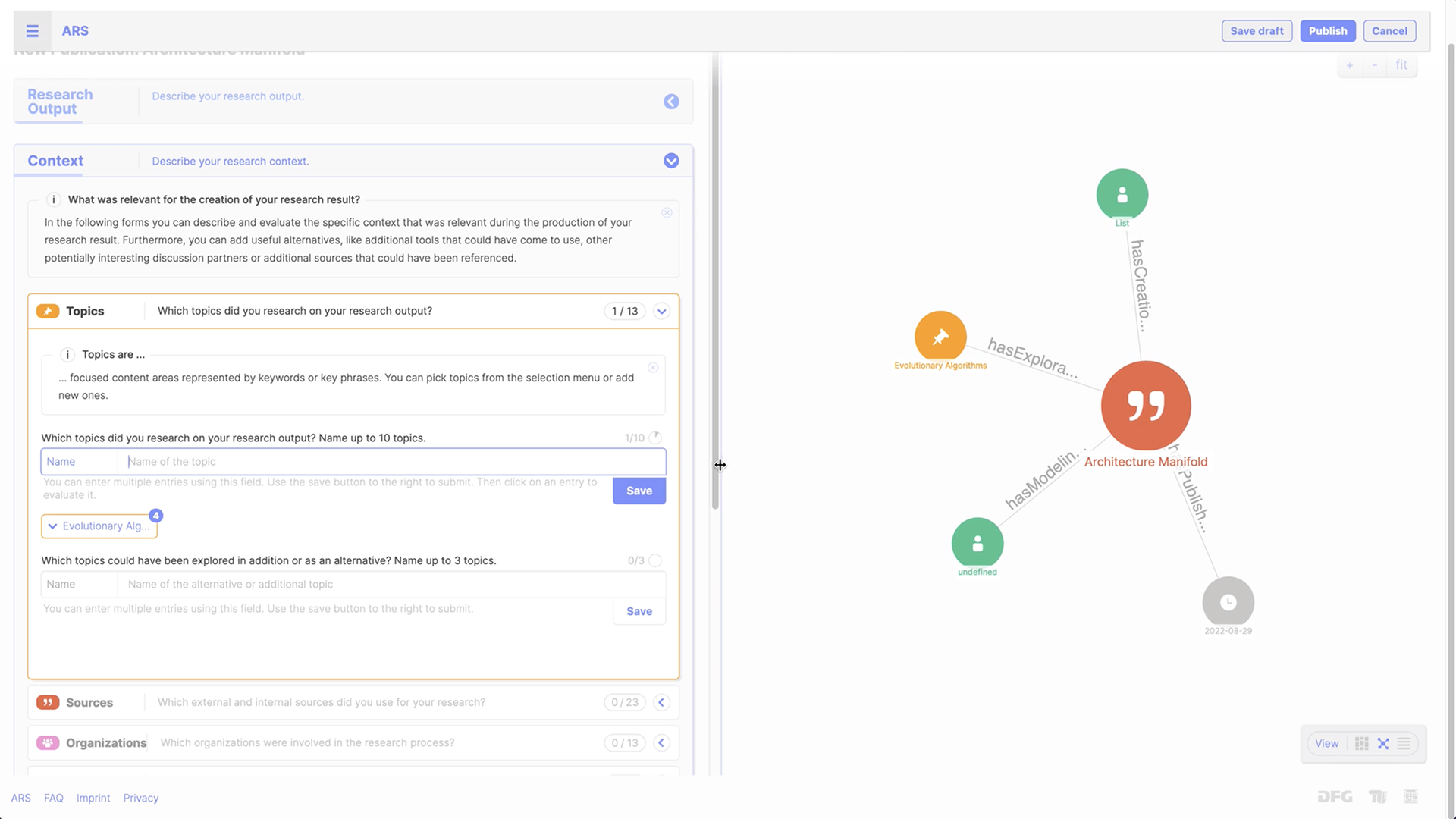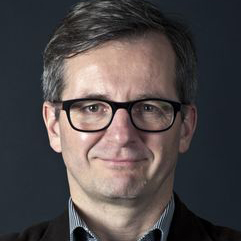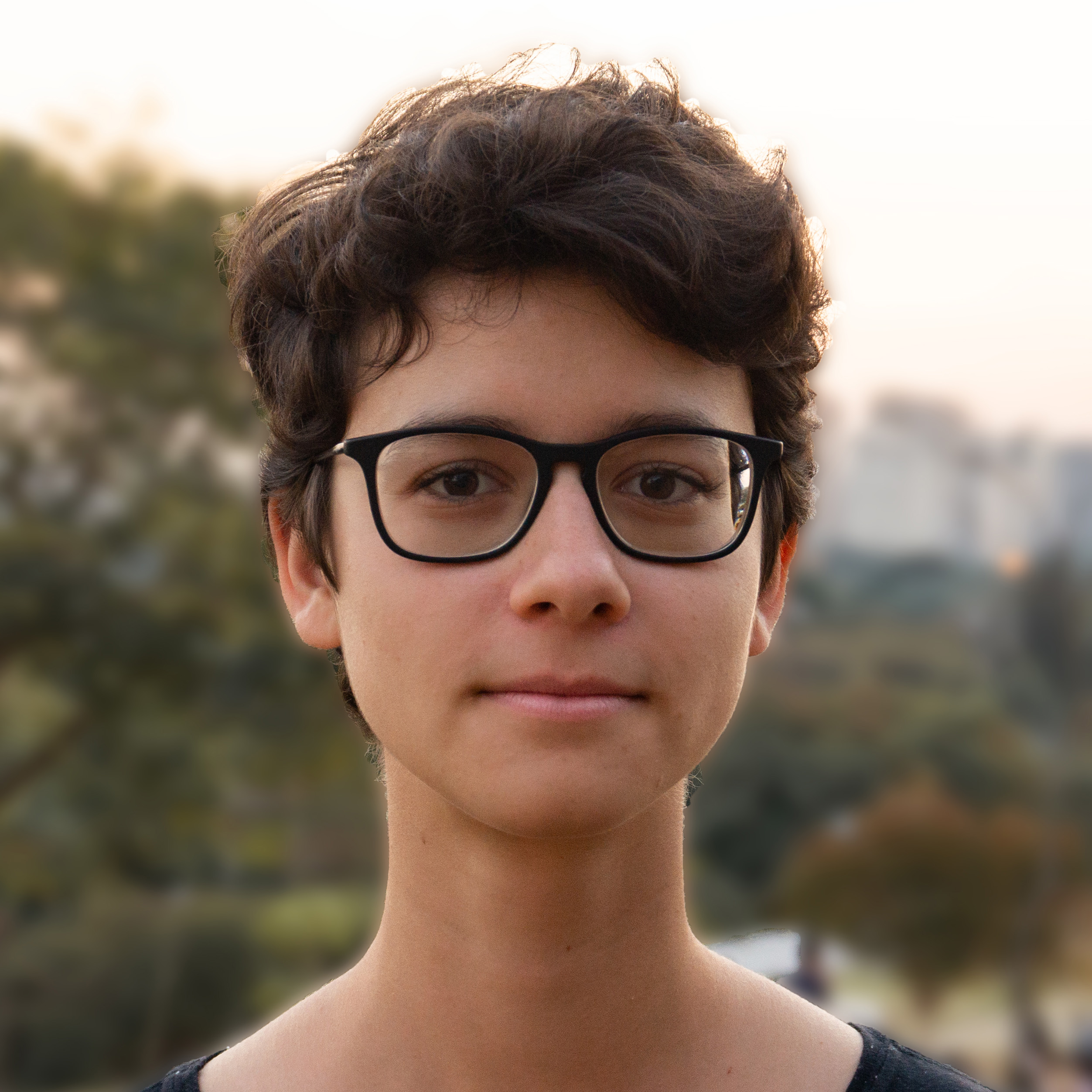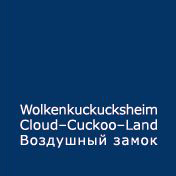About
Welcome to the Architecture Research Stage (ARS) - the open stage for all actors in architecture research!
The Architecture Research Stage is a platform for networking architecture research. It connects results, data and contexts of academic disciplines, research-oriented teaching and non-academic practices to enable interdisciplinary collaborations.
Researchers use a collaboration model to annotate their respective research contexts.
Using graph technology, ARS links research contexts and research outputs automatically to build a network graph.
An image-based interface displays the actor network of architecture research and makes it explorable.
Willkommen auf der Architecture Research Stage - der offenen Bühne für alle Akteure der Architekturforschung!
Die Architecture Research Stage ist eine Plattform für die Vernetzung von Architekturforschung. Sie verbindet Ergebnisse, Daten und Kontexte akademischer Fachdisziplinen, forschungsorientierter Lehre und außerakademischer Praxis, um interdisziplinäre Kollaborationen zu ermöglichen.
Auf Grundlage eines Kollaborationsmodells werden die jeweiligen Entstehungskontexte durch die Forschenden eigenständig annotiert.
Mittels Graphentechnologie werden Forschungskontexte und Forschungsergebnisse zu einem Netzwerkgraphen automatisch vernetzt.
Über ein bildbasiertes Interface wird das Akteursnetzwerk der Architekturforschung dargestellt und explorierbar gemacht.

Use Cases
Use Cases

PlusPublication
PlusPublication
plusPublications are a core element of ARS. They provide a connection to the context in which the research results were obtained.
The plusPublications that researchers produce always provide additional information about the development of the project: Which tools were used, which events influenced the research process, where was work done, which tasks had to be completed, how much time and money was available? The description of the context, generated by a specially developed collaboration model, produces a complex network of players and factors. In combination with other plusPublications, this results in a diversity of connections.
Zentrales Element von ARS sind die plusPublikationen, die Forschungsergebnisse mit deren konkretem Entstehungskontext verbinden.
Die von den Forschenden erstellten plusPublikationen berichten immer auch etwas über ihre eigene Entstehung: Welche Werkzeuge wurden verwendet, welche Ereignisse haben den Forschungsprozess beeinflusst, an welchen Orten wurde gearbeitet, welche Aufgaben mussten erledigt werden, wieviel Zeit und Geld stand zur Verfügung? Die Beschreibung des Kontextes mittels eines eigens entwickeltes Kollaborationsmodells generiert ein komplexes Netzwerk unterschiedlicher - menschlicher und nicht-menschlicher - Akteure. Zusammen mit anderen plusPublikationen ergeben sich so vielfältige Verbindungen.
ActorCard
ActorCard
Architecture research uses a wide variety of media types: texts, images, drawings, models, films, code and more.
ARS has the ambition to make research results of any type of media equally accessible using specifically developed means of presentation such as the Actor Card.
Architekturforschung nutzt eine große Bandbreite an Medien: Texte, Bilder, Zeichnungen, Modelle, Film, Code und mehr...
ARS will Forschungsergebnisse unterschiedlichster Medialität gleichsam Zugänglich machen. Hierfür kommen eigens entwickelte Präsentationsmittel wie Beispielsweis die Actor Card zum Einsatz.
Prototype
Prototype
ARS Stage & Context View
ARS Modeling Tool
Team & Partners
Team & Partners
ARS is an experimental pilot project conducted in cooperation with Technische Universität Berlin and Universität der Künste Berlin.
The project is being implemented by an interdisciplinary team with the participation of academic and non-academic partners in the Berlin-Brandenburg area.
ARS ist ein experimentelles Pilotprojekt im Verbund der Technischen Universität Berlin und der Universität der Künste Berlin.
Ein interdisziplinäres Team führt das Projekt unter Beteiligung von Kooperationspartnern aus dem akademischen und außer-akademischen Bereich in Berlin-Brandenburg durch.
Core Team

Prof. Dr. Susanne Hauser
Project Head - UdK Berlin
Art History and Cultural Studies
hauser [at] udk-berlin.de

Prof. Dr. Norbert Palz
Project Head - UdK Berlin
Digital and Experimental Design
n.palz [at] udk-berlin.de

Prof. Dr.-Ing. Jörg Gleiter
Project Head - TU Berlin
Architecture Theory
joerg.gleiter [at] tu-berlin.de

Dr.-Ing. Michael Dürfeld
Project Coordinator - TU Berlin
Architecture Theory
michael.duerfeld [at] tu-berlin.de

M.Sc. Zead Rahman
Developer - TU Berlin
Computer Science

M.A. Ferdinand List
Interaction Design - UdK Berlin
Architecture
f.list [at] udk-berlin.de

Dr. Christian Stein
Semantic Web Expert - HU Berlin
Matters of Activity
christian.stein [at] hu-berlin.de

Renata Altenfelder Dias
Project Assistance - UdK Berlin
Visual Communication

B.A. Niklas Thran
Project Assistance - UdK Berlin
Visual Communication

Prof. Dr.-Ing. Michael Prytula
Urban Future, Fachhochschule Potsdam
Project Partners

Prof. Dr. Susanne Junker
Design, Interior Design, Visualization, Berliner Hochschule für Technik

Prof. Ilija Vukorep
Digital Methods of Design, BTU Cottbus Senftenberg

Hybrid Platform
TU Berlin & UdK Berlin

Design and Computation Program Master
TU Berlin & UdK Berlin

Deutsches Architektur Zentrum

Netzwerk Architekturwissenschaft e.V.

Wolkenkuckucksheim
Internationale Zeitschrift zur Theorie der Architektur

Rob Bogucki
Fathomable Ltd, VR Development
Phase I: Launch
In the launch phase, an existing prototype from the earlier project ID+Lab will be adapted to meet the specific needs of the architecture research community and extended with additional functionality.
Phase I: Start
In der Startphase wird ein bestehender Prototyp aus dem Vorgängerprojekt ID+Lab anhand der spezifischen Bedarfe der Architekturforschung angepasst und um zusätzliche Funktionen erweitert.
Phase II: Networking
In the networking phase, the first version of the Architecture Research Stage will be tested, evaluated and further developed with a selection of partners.
Phase II: Vernetzung
In der Vernetzungsphase wird die erste Version der Architecture Research Stage mit einer Auswahl von Kooperationspartnern erprobt, evaluiert und weiterentwickelt.
Phase III: Application
In the application phase, the second version will be supplemented with functionality that addresses the specific needs of a publication and networking platform for architecture research.
Phase III: Anwendung
In der Anwendungsphase wird die zweite Version mit Funktionalitäten ergänzt, die auf spezifische Bedarfe an eine Publikations- und Vernetzungsplattform der Architekturforschung eingehen.
Phase IV: Expansion
In the expansion phase, the third version is further developed with a large number of new partners.
Phase IV: Expansion
In der Expansionsphase wird die dritte Version mit einer großen Vielzahl neuer Kooperationspartner weiterentwickelt.
Phase I: Launch
Phase I: Start
Phase II: Networking
Phase II: Vernetzung
Phase III: Application
Phase III: Anwendung
Phase IV: Expansion
Contact
Contact
Get in touch and join the collaboration!
Whether you are a researcher, businessperson, student or teacher: become an early adopter and bring your demands and expertise to the ARS project. Network with other actors in the field of architecture and contribute to the building of the architecture research infrastructure of the future.
Setzen Sie sich in Verbindung und nehmen Sie an der Zusammenarbeit teil!
Egal ob Sie in Forschung, Praxis, Studium oder Lehre tätig sind: Werden Sie Early Adopter und bringen Sie Ihre Anforderungen und ihre Expertise mit in das ARS-Projekt. Vernetzen Sie sich mit anderen Akteuren der Architekturforschung und tragen sie gemeinsam zur Architektur-Forschungsinfrastruktur von morgen bei.



